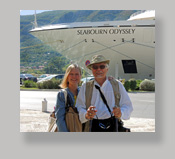 
VENICE | CROATIA | MONTENEGRO | CORFU | KAFALONIA | PYLOS | NAFPLION | PIRAEUS | MILOS | MYKONOS PATMOS | KUSADASI | CHIOS | ISTANBUL DAY 1 | ISTANBUL DAY 2 | ISTANBUL DAY 3 | TRAVEL REFLECTIONS |
 
VENICE | CROATIA | MONTENEGRO | CORFU | KAFALONIA | PYLOS | NAFPLION | PIRAEUS | MILOS | MYKONOS PATMOS | KUSADASI | CHIOS | ISTANBUL DAY 1 | ISTANBUL DAY 2 | ISTANBUL DAY 3 | TRAVEL REFLECTIONS |
PATMOS 9-2-12
Although this island, like the rest of the Greek isles, is rich in history and conquerors, it is best know for an action taken while it was under Roman rule. St. John, of Matthew-Mark-Luke-John Apostles fame, was exiled to the Island in the year 95 A.D. by the ruling Roman emperor. In a cave half way up one of the Patmos mountains he wrote Revelations, the last book of the Christian Bible. Our first stop from the ship is the town of Skala where we board a bus to visit what is now called the Holy Cave of the Apocalypse. To get to the cave, we had to walk down 50 or so stone steps, no two of which were the same height. When St. John was living in it, the cave opened to a beautiful view of the sea and a large expanse of other portions of the island. A "chapel" was later built in front of the cave entrance although the cave face was preserved. The guide pointed out where St. John supposedly used a slight hollow in one part of the cave wall as a stone pillow. Tradition says that in a spot where the substantial dome of the cave splits into three sections forming a clear triangle, St. John heard the voice of God.
From the Monastery we visited what was called the oldest continuously occupied home on the island, which is now on its 8th generation. (Somehow that doesn't make sense, but that's what the plaque on the wall said.) We met the engaging matriarch, a woman in her mid-80's, who opens the upper floor of her home as a museum. There were rooms filled with just about everything from trays and plates to elaborate and lacy bed canopies. I think she opens her home because she is basically a gregarious Greek who enjoys having a steady stream of company, especially if she can sell them some local hand-crocheted coasters and similar items.
|